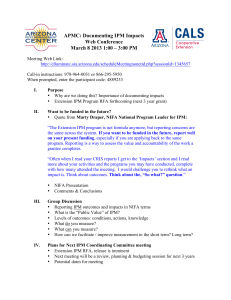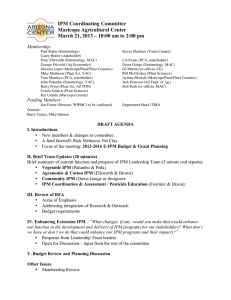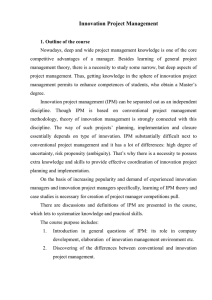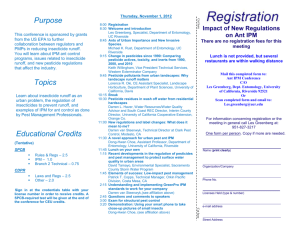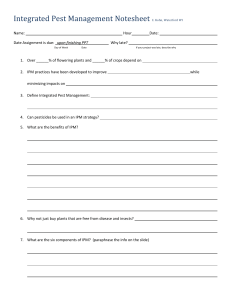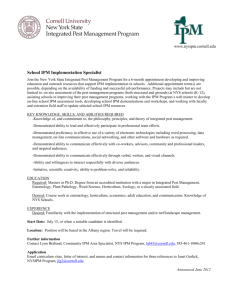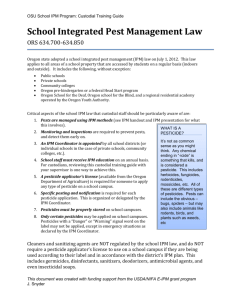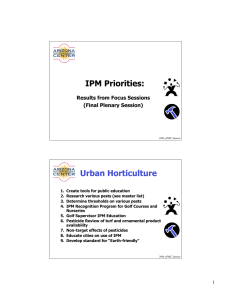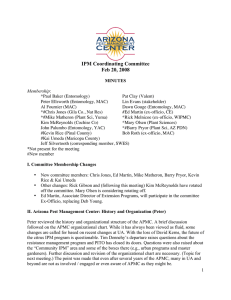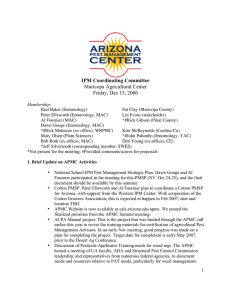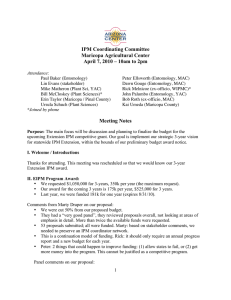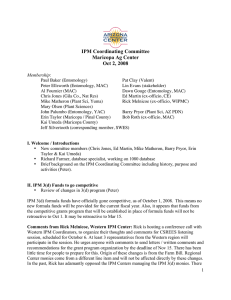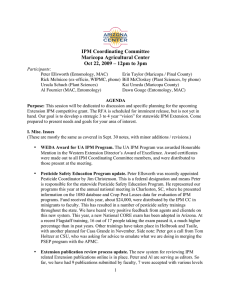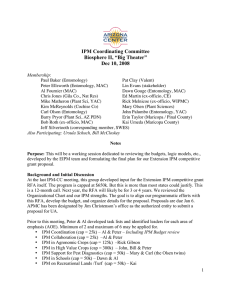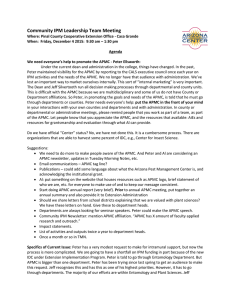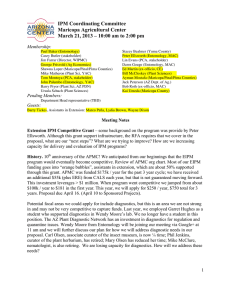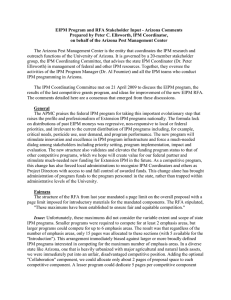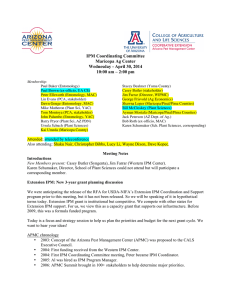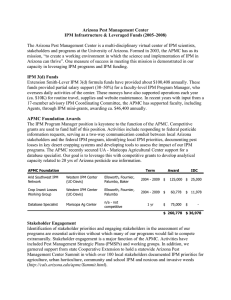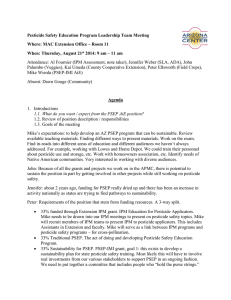IPM Coordinating Committee Maricopa Agricultural Center April 21, 2009
advertisement
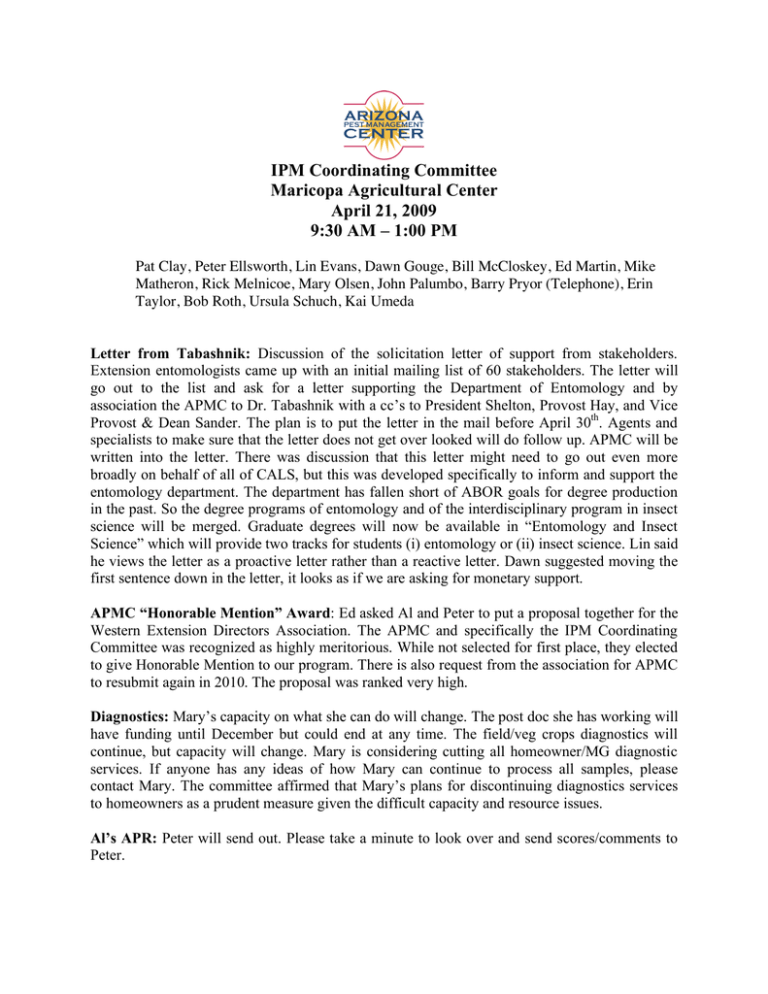
IPM Coordinating Committee Maricopa Agricultural Center April 21, 2009 9:30 AM – 1:00 PM Pat Clay, Peter Ellsworth, Lin Evans, Dawn Gouge, Bill McCloskey, Ed Martin, Mike Matheron, Rick Melnicoe, Mary Olsen, John Palumbo, Barry Pryor (Telephone), Erin Taylor, Bob Roth, Ursula Schuch, Kai Umeda Letter from Tabashnik: Discussion of the solicitation letter of support from stakeholders. Extension entomologists came up with an initial mailing list of 60 stakeholders. The letter will go out to the list and ask for a letter supporting the Department of Entomology and by association the APMC to Dr. Tabashnik with a cc’s to President Shelton, Provost Hay, and Vice Provost & Dean Sander. The plan is to put the letter in the mail before April 30th. Agents and specialists to make sure that the letter does not get over looked will do follow up. APMC will be written into the letter. There was discussion that this letter might need to go out even more broadly on behalf of all of CALS, but this was developed specifically to inform and support the entomology department. The department has fallen short of ABOR goals for degree production in the past. So the degree programs of entomology and of the interdisciplinary program in insect science will be merged. Graduate degrees will now be available in “Entomology and Insect Science” which will provide two tracks for students (i) entomology or (ii) insect science. Lin said he views the letter as a proactive letter rather than a reactive letter. Dawn suggested moving the first sentence down in the letter, it looks as if we are asking for monetary support. APMC “Honorable Mention” Award: Ed asked Al and Peter to put a proposal together for the Western Extension Directors Association. The APMC and specifically the IPM Coordinating Committee was recognized as highly meritorious. While not selected for first place, they elected to give Honorable Mention to our program. There is also request from the association for APMC to resubmit again in 2010. The proposal was ranked very high. Diagnostics: Mary’s capacity on what she can do will change. The post doc she has working will have funding until December but could end at any time. The field/veg crops diagnostics will continue, but capacity will change. Mary is considering cutting all homeowner/MG diagnostic services. If anyone has any ideas of how Mary can continue to process all samples, please contact Mary. The committee affirmed that Mary’s plans for discontinuing diagnostics services to homeowners as a prudent measure given the difficult capacity and resource issues. Al’s APR: Peter will send out. Please take a minute to look over and send scores/comments to Peter. I. EIPM Funding Update II. Update from CSREES listening sessions / IPM Symposium 53 proposals were received; Arizona was ranked in the High Priority category. Arizona got the largest increase (%) over all proposals. We were dinged on generality. It was discussed during the listening session to have a page limit per emphasis area. A formal letter will be sent on how Arizona feels about the RFA. Request that the panel become more familiar with extension, western agriculture, and IPM. We followed the logic model in proposal development, but not all states liked this approach. Panelists criticized that they could not adequately discern the outreach in our proposal. The emphasis areas are expected to remain the same. The current allocation can be readjusted to meet our needs. • • Public comments on revised RFA due by April 29 National Program Leaders presented stakeholders with the following questions: 1. What is the role of CSREES funding in state, regional, national programs? 2. What should be the primary goals and objectives of the EIPM program? 3. How can we engage all eligible institutions? 4. Please provide input on evaluation criteria. 5. What specific program areas need to have national support? Issues identified by the APMC for comment to the national EIPM program: Page limits: The original limit was 20 pages, 5 for intro., 15 for everything else. (8 components total). [Refer to comment letter posted on the APMC site for more details of this and other issues that follow below.] Panel Makeup: There needs to be a relevance panel (stakeholders), or some understanding of all programs. Some IPM Coordinators on the panel across the regions, and IPM Center Directors (non voting, just a director). Emphasis areas: Do we want the cap to stay the same? Do we want some areas lower and some higher? What should the cap overall be, and should there even be a cap on the areas? 500,000 cap on overall proposal. $500,000 per year for 3 years ($1.5 million total). How many years? At least 2, no more than 4. 3 would be a good amount. People will be locked out if they do not get any money. Collaboration: Do away with it and just provide info that there is collaboration. Make it more generalized? They want verifiable collaboration efforts. Cap was $25,000. Do we want to keep it? Will AZ be competitive? Coordination: Is $25,000 insufficient? Some other states thought to go up to $75,000. This means that that amount of money will come right off the top of the total amount available, because awards for “coordination” are likely to be more lenient. Some states wanted to make this part of the award automatic. Bill suggested that leaving it alone and incorporating a portion of coordination into other areas as we did this year. Put in the letter that the increase be conservative, no more than $40,000 for coordination. Logic Model: Is it appropriate? YES! The model/planning tool needs to be clearly defined in the proposal. Outreach: Address outreach in the program sufficiently. • Proposed IPM budget – new funds and carry-over – discussion Infrastructure: Peter asked Al to give him a budget and he came up with about 101K. After the preliminary award notice, which was a cut from our request, Al went back and looked at it again and was able to get it down to $94K. This includes all web work, some operations, half-time salary for Richard Farmer (database specialist), and half of Al’s salary. The remaining salary in the High Value IPM area could be for a person that does similar work to Al but at the emphasis area level, mainly to support vegetable and cotton IPM. The person would put together information / meetings / demonstrations / publications. Would work with the Agents/specialists on putting together the program. Budget: All people that received a small amount, need to write a justification on what they will use the funds for. The possibility of pooling funds to hire assistants in extension is an option. Funds for the high value, may go to hiring 1 assistant in extension that will provide support across the state. Get ideas and numbers to Peter. • New Roadmap for Agriculture research, education & outreach: public comments due by May 31 What are the important issues coming from ag, how should we support activities, coordination, priorities, etc.? A letter will be sent by Rick and Peter will look at it and put something together for the IPM CC to review for submission for public comment. This effort could lead to some additional funds in the future. This is a very broad agenda. II. Pesticide Safety Education Program (PSEP) proposal review Paul Baker: The need for representation at regional and national PSEP meetings was not considered when developing this year’s RFA. This was an oversight. As a result, this proposal did not really fit the RFA, but it is important for someone to go to the regional Pesticide Meetings and represent Arizona’s interests. The committee thought that we should either include this in the RFA in the future or simply take it off the top of the PSEP funds each year. Al Fournier: Designed to help other CE Agents/Specialists to deliver Pesticide programs. The list of team members was constructed to include only those not otherwise submitting proposals, but eligibility is for anyone in CE Dawn Gouge: To assist in the development of a training symposium for pest applicators. Rob Grumbles: Deliver pesticide programs to stakeholders up on the strip. Kai Umeda: To do training in the NE part of the state and up to Flagstaff. This would consolidate it into 1 training during a week. (road show). At the end of the program, the pesticide test will be given. All new materials will be developed by Ed Northam. Ranking: Fournier Gouge Grumbles Umeda/Schalau Baker request--award $5000---$5000 $5000---$5000 $3050---$3050 $10500---$10150 $1500----$1500 Paul will be encouraged to apply for professional development funds. Extra money may be given to Kai. [UPDATE: Paul was unable to make arrangements to go to the regional meetings in May. Instead he suggested that the money awarded to him be used to go to the national meeting in Charleston, SC, in August.] III. Extension IPM publications • FastTrack system and procedures for IPM review Up and running. Lin expressed some problems with the system as a reviewer. PDF’s are hard to comment on. It is a peer review process, especially good for junior faculty. Reviewers are in-state, out of state and out of institution. Dawn would like to be able to see the revised publication. Working on trying to make it where the reviewer is encourage to write comments for each question rather than just yes or no. Other states are asking us to put together a list of experts that is related to specific areas, so that we can share potential reviewers. • Plan to review all pest management publications > 5 years old All publications across extension will be reviewed and either rewritten or pulled. If there are minor revisions, peer review is not necessary. This is determined by the author. IV. Lunch / Other Issues (time permitting, ending at 1:00) • Next meeting: Idea is to have a meeting in Mid August. The RFA is expected to be released in July with a deadline of Mid September.
